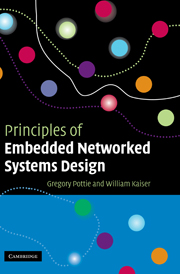
-
Select format
-
- Publisher:
- Cambridge University Press
- Publication date:
- 10 August 2009
- 15 September 2005
- ISBN:
- 9780511541049
- 9780521840125
- 9780521095235
- Dimensions:
- (247 x 174 mm)
- Weight & Pages:
- 1.239kg, 548 Pages
- Dimensions:
- (244 x 170 mm)
- Weight & Pages:
- 0.86kg, 548 Pages
You may already have access via personal or institutional login
Book description
Embedded network systems (ENS) provide a set of technologies that can link the physical world to large-scale networks in applications such as monitoring of borders, infrastructure, health, the environment, automated production, supply chains, homes and places of business. This book details the fundamentals for this interdisciplinary and fast-moving field. The book begins with mathematical foundations and the relevant background topics in signal propagation, sensors, detection and estimation theory, and communications. Key component technologies in ENS are discussed: synchronization and position localization, energy and data management, actuation, and node architecture. Ethical, legal and social implications are addressed. The final chapter summarizes some of the lessons learned in producing multiple ENS generations. A focus on fundamental principles together with extensive examples and problem sets make this text ideal for use on graduate courses in electrical engineering and computer science. It will also appeal to engineers involved in the design of ENS.
Reviews
"…this volume represents a real mine of information…anyone working in the field would benefit from owning a copy."
IEEE Communications Engineer
Contents
Metrics
Full text views
Full text views help Loading metrics...
Loading metrics...
* Views captured on Cambridge Core between #date#. This data will be updated every 24 hours.
Usage data cannot currently be displayed.
Accessibility standard: Unknown
Why this information is here
This section outlines the accessibility features of this content - including support for screen readers, full keyboard navigation and high-contrast display options. This may not be relevant for you.
Accessibility Information
Accessibility compliance for the PDF of this book is currently unknown and may be updated in the future.


